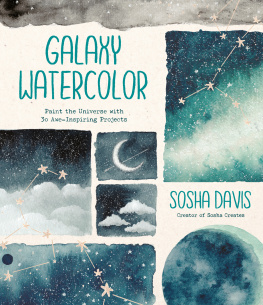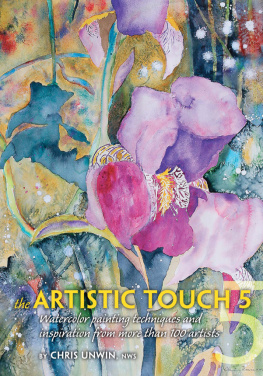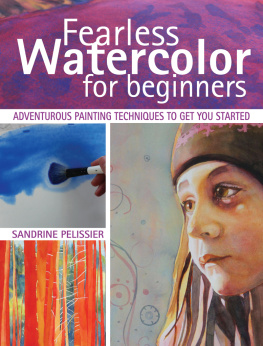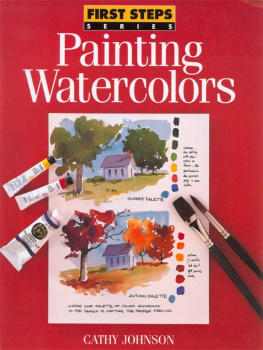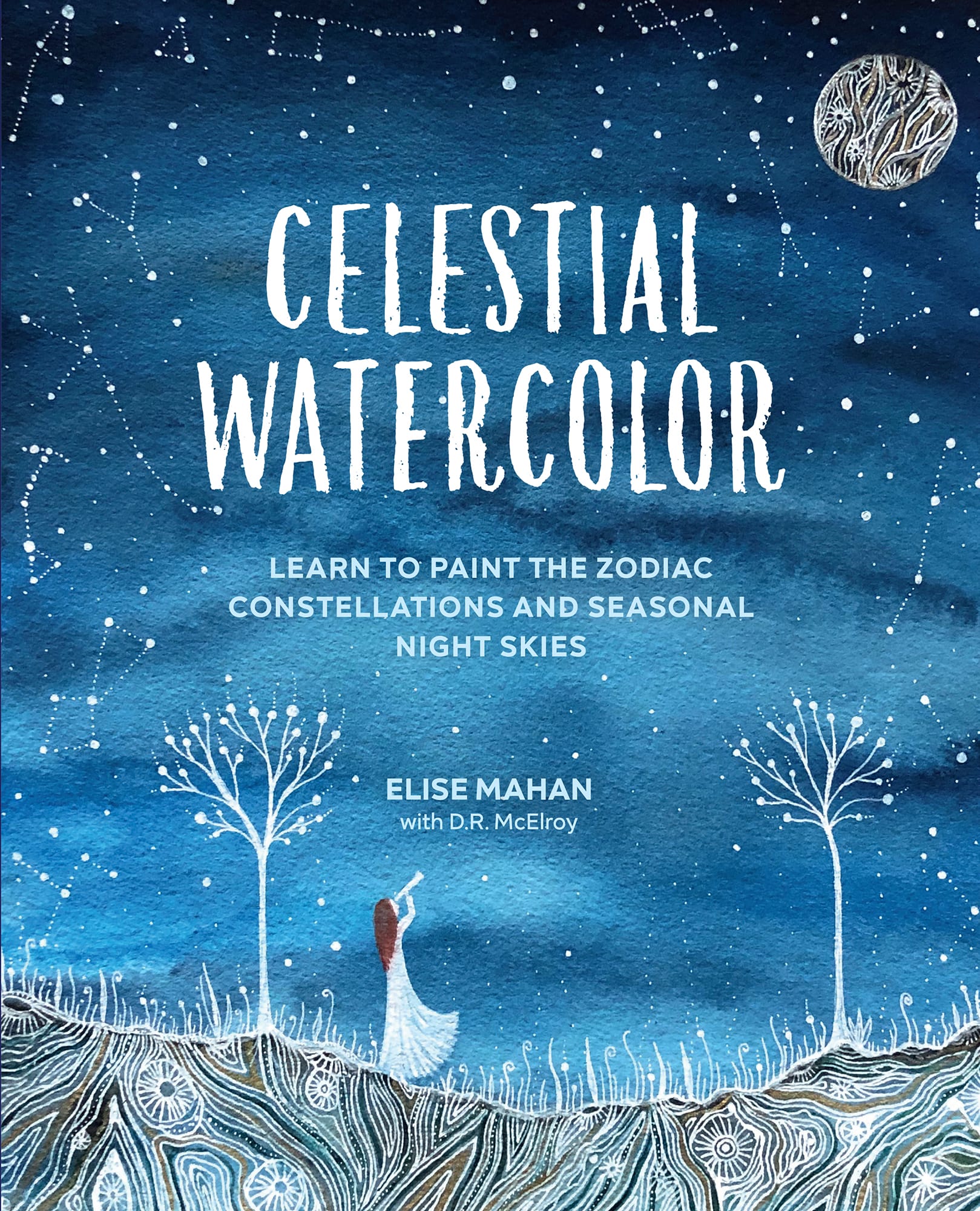CELESTIAL WATERCOLOR
LEARN TO PAINT THE ZODIAC CONSTELLATIONS AND SEASONAL NIGHT SKIES
Elise Mahan with D.R. McElroy

Introduction
I grew up in the lush and verdant forests of Northern California in a family of artists, musicians, and writers. My love for art and nature began there among the starry nights and majestic redwood trees that towered above the place we called home. They stood as a constant reminder of the beauty and power of the natural world and served as a source of reflection for me.
Even as a child I was always making artwork influenced by my adoration of nature. I could often be found working in my sketchbook, making still-life drawings using the flowers and botanical elements I found growing on our land. Some of my favorite childhood memories were the nights my family would gather our coziest blankets and lay them in the field near our home to stargaze. We would listen to the sound of the wind move through the trees, make up new constellations, learn about ancient ones, and sing songs about the moon. The wild environment, along with those starry nights, always remain with me as my muse as well as a source of inspiration when I paint.
I studied art history in college, where most of my classes were focused on learning the names of artists and writing long essays about them. As much as I adore art history and am constantly inspired by the artists I learn about, I found myself drawn to creating art rather than writing about it. I work with watercolor because I love the layered quality it gives my paintings; their range of colors; their quick-drying nature; and the fact that it is possible to purchase nontoxic watercolors, which helps a great deal because I share my studio with a curious two-year-old who constantly wants to explore all of my art materials.
In this book you can find a guide to the various techniques I use to create my celestial paintings, as well as my preferred art materials and my artistic process. You may use this book to create your own sky inspired by the four seasons, learn about the constellations and astrological signs, and practice different techniques to achieve a luminous moon painting. Thank you for looking and I hope you enjoy my celestial corner of the universe.
Elise Mahan
H ave you ever gazed at the night sky in wonder and awe, and felt a need to somehow capture or contain its vast splendor into something more intimate and understandable? It is not uncommon for us humans to feel overwhelmed by the enormity of the universe and our tiny place in it. Millennia of artists, philosophers, and storytellers have drawn inspiration from the stars, and over time we have tried to grasp the vastness of the heavens by identifying and naming familiar clusters of light that we could repeatedly locate and refer to.
Nearly everyone has heard of the Big and Little Dippers in the Northern Hemisphere. Some cultures refer to them as Ursa Major (The Great Bear) and Ursa Minor (The Little Bear). Other familiar constellations were noted by the ancient Greeks, and bear Greek names: Orion, Cassiopeia, and the Pleiades, for example. Arguably, however, it is the zodiac constellations that have had the greatest impact on humanity.
The study of the physical universeits stars, planets, and spaceis called astronomy. The study of the movements of heavenly bodies as they affect the world and human affairs is called astrology. Astronomy is science; astrology is more of an art or philosophy. The field of knowledge in both practices is as enormous as the cosmos itself. An astronomist may spend her life studying a tiny fraction of the galaxy, while an astrologist can spend a lifetime pursuing the subtleties of polarity, mutability, modality, and dignity in his art.
This book is not about either discipline. It is an art book about painting constellations, and as such the entire scope and depth of the philosophy and practice of astrology in particular is beyond our ability to explore here.
It is our intent in this book to help you capture the wonder of the night sky by learning to paint the constellations of the zodiac. Each constellation will be demonstrated by Elise, and she will provide tips and techniques for placing these constellations on your canvas, as well as where to locate them in the sky. Background information on the signs and their characteristics in astrology will also be provided. We will end with a discussion of the moon and its phases in different cultures as well.
D.R. McElroy
Tools & Techniques
Watercolor is an incredibly diverse medium, and with just a few materials you can create your own celestial paintings inspired by the beauty and power of the cosmos. In the following pages I have included a few of my favorite tools and materials that I work with. However, I encourage you to experiment with a variety of paints, pens, brushes, and papers throughout your artistic journey, as you will certainly find something unique that works for your style of watercolor painting. It is my hope that this book will inspire you to explore the endless possibilities that watercolor has to offer.
TOOLS
Watercolor Papers
T here are several different types of watercolor papers you can use to make your paintings. There is hot press (smooth); cold press, which has a little texture to it; and rough press, which has the most tooth, or texture, to it as well as the longest dry time. I generally prefer to paint on cold-press watercolor paper for most of my paintings, as it contains a beautiful rough texture in addition to being smooth enough to achieve incredible detail with both watercolor and ink.
As with any material, I think its a great idea to try out a range and decide what works best for your paintings. You will find that hot press has a smooth quality to the paper, and as a result, the paint will dry faster. I like the rougher textures because it also gives me the ability to work in layers without worrying about saturating my paper with too much paint, or causing the paper to shed, buckle, or rip. I tend to work on heavier, artist-grade papers so that I can layer and experiment.
There are some great student-grade papers made by Strathmore that are 140 lb, which tells you the weight or thickness of the watercolor paper. You can purchase as thin as 45 lb and as thick as 300 lb. For most of my celestial paintings, I like to use extra-heavy 300 lb paper, because making a luminous sky requires much layering. Below I have included a list of a few paper suggestions that might assist you in choosing an appropriate watercolor paper. Artist-grade paper is generally a better price and is good for studies and smaller works. I like professional watercolor paper because it is archival, which means that it will not age or yellow over time.





